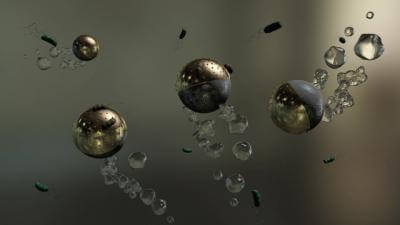The team designed "double-faced" spherical particles to perform the task. One side of the robots is made of magnesium, which in contact with water creates bubbles that will enable the robotic bacteria to move. The other side of the robot is made of alternating layers of iron and gold topped with silver particles. The bacteria stick to the gold and are eliminated by the silver. The iron is designed to pull them out at the end of their operation using a magnet

The lack of clean water in many areas around the world is an ongoing public health problem. One day, tiny robots could help address this problem by cleaning polluted water of disease-causing bacteria. Scientists from the Max-Planck Institute for Intelligent Systems in Germany report a new development towards this goal in the journal ACS Applied Materials & Interfaces.
The pathogenic bacteria have developed resistance to disinfectants and also antibiotics that are used by humans. Drinking water contaminated with pathogenic bacteria can cause serious diseases, which in areas with sparse medical services can be life-threatening without proper treatment. Water can be disinfected with chlorine or other disinfectants, but there are some extremely resistant bacteria and microorganisms that are difficult to remove. Treating water with a combination of disinfectants can help, but they remain in the water, and their byproducts can be harmful to human health.
To meet the challenge of purifying water contaminated with E.coli bacteria, the research team created what they call "Janus-type microbots," to collect and kill E.coli bacteria as they swim in the polluted water.
"Janus" is a god from Roman mythology associated with time, beginnings and endings. Janus is always depicted as having two faces. This original definition of being "two-faced" accurately describes the robotic bacterium. Its surface is round and it is divided into two parts, with each half made of different parts to allow the robot to perform its different roles.
The team designed "double-faced" spherical particles to perform the task. One side of the robots is made of magnesium, which in contact with water creates bubbles that will enable the robotic bacteria to move. The other side of the robot is made of alternating layers of iron and gold topped with silver particles. The bacteria stick to the gold and are eliminated by the silver. Laboratory tests showed that particles that could move in water for 15 to 20 minutes captured more than 80 percent of the E. coli bacteria that were introduced into the water at high concentrations. Then, thanks to the magnetic properties of the iron, the robots retrieve the bacteria from the water without leaving behind any harmful waste.

6 תגובות
To my father - (the one who wrote first and who offered silver membranes.)
Water filters that contain silver have been present in home water purifiers for many years.
In such a water purifier, in the same column that cleans the water, there are also granules that contain silver that prevent the growth of bacteria.
There are many methods for purifying water - the most common disinfection is with halogens that evaporate after their disinfection action, such as chlorine, bromine, iodine... and there is also the use of UV lamps, as well as ozone gas, and filters that contain silver. It is not so clear from the article what the advantage of the new patent is over the existing ones.
Which team is it about?
Yesterday, by chance, National Geographic aired a futuristic apocalyptic scenario about nano-robots that are able to digest any organic material and reproduce on their own.
These nano-robots were intended to purify water and were released by a frustrated employee of the company that developed them, causing an apocalyptic disaster when they begin to digest humans as well...
When you think about the process and the investment in it: nano robots, a closed facility, strong magnets
for the collection of the robots and the quality of the water that will be obtained at the end (the water may be free of bacteria
causes of diseases but not from the other pollutants), it seems to me that it is better to desalinize the water.
Robotic bacteria is a somewhat bombastic name for something that is not a robot, and certainly not a bacteria. At most you can call them "complex nanoparticles".
Silver is known to kill germs. Therefore it might be better to filter the water through membranes made of silver?